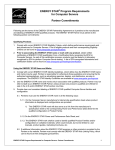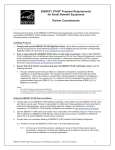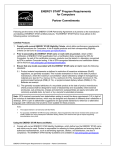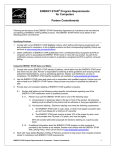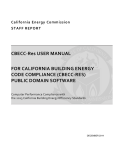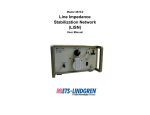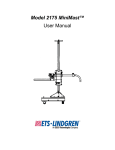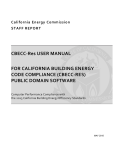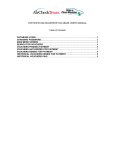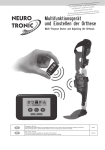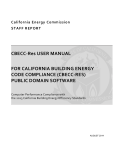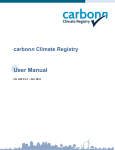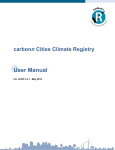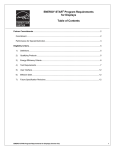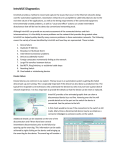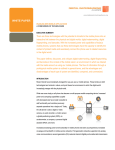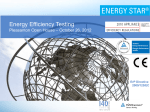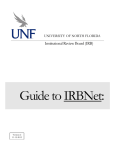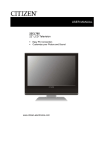Download ENERGY STAR Program Requirements for Roof Products V3
Transcript
ENERGY STAR® Program Requirements for Roof Products Partner Commitments Following are the terms of the ENERGY STAR Partnership Agreement as it pertains to the manufacture and labeling of ENERGY STAR qualified products. The ENERGY STAR Partner must adhere to the following partner commitments: Qualifying Products 1. Comply with current ENERGY STAR Eligibility Criteria, which define performance requirements and test procedures for roof products. A list of eligible products and their corresponding Eligibility Criteria can be found at www.energystar.gov/specifications. 2. Prior to associating the ENERGY STAR name or mark with any product, obtain written certification of ENERGY STAR qualification from a Certification Body recognized by EPA for roof products. As part of this certification process, products must be tested in a laboratory recognized by EPA to perform roof product testing. A list of EPA-recognized laboratories and Certification Bodies can be found at www.energystar.gov/testingandverification. Using the ENERGY STAR Name and Marks 3. Comply with current ENERGY STAR Identity Guidelines, which define how the ENERGY STAR name and marks may be used. Partner is responsible for adhering to these guidelines and ensuring that its authorized representatives, such as advertising agencies, dealers, and distributors, are also in compliance. The ENERGY STAR Identity Guidelines are available at www.energystar.gov/logouse. 4. Use the ENERGY STAR name and marks only in association with qualified products. Partner may not refer to itself as an ENERGY STAR Partner unless at least one product is qualified and offered for sale in the U.S. and/or ENERGY STAR partner countries. 5. Provide clear and consistent labeling of ENERGY STAR qualified roof products. 5.1. The ENERGY STAR mark must be clearly displayed in product literature (i.e., user manuals, spec sheets, etc.) and on the manufacturer’s Internet site where information about ENERGY STAR qualified models is displayed. 5.2. It is also recommended that the mark appear on the product packaging. Verifying Ongoing Product Qualification 6. Participate in third-party verification testing through a Certification Body recognized by EPA for roof products, providing full cooperation and timely responses. EPA/DOE may also, at its discretion, conduct tests on products that are referred to as ENERGY STAR qualified. These products may be obtained on the open market, or voluntarily supplied by Partner at the government’s request. Providing Information to EPA 7. Provide unit shipment data or other market indicators to EPA annually to assist with creation of ENERGY STAR market penetration estimates, as follows: ENERGY STAR Program Requirements for Roof Products – Partner Commitments 1 7.1. Partner must submit the total number of ENERGY STAR qualified roof products shipped in the calendar year or an equivalent measurement as agreed to in advance by EPA and Partner. Partner shall exclude shipments to organizations that rebrand and resell the shipments (unaffiliated private labelers). 7.2. Partner must provide unit shipment data segmented by meaningful product characteristics (e.g., type, capacity, presence of additional functions) as prescribed by EPA. 7.3. Partner must submit unit shipment data for each calendar year to EPA or an EPA-authorized third party, preferably in electronic format, no later than March 1 of the following year. Submitted unit shipment data will be used by EPA only for program evaluation purposes and will be closely controlled. If requested under the Freedom of Information Act (FOIA), EPA will argue that the data is exempt. Any information used will be masked by EPA so as to protect the confidentiality of the Partner. 8. Report to EPA any attempts by recognized laboratories or Certification Bodies (CBs) to influence testing or certification results or to engage in discriminatory practices. 9. Notify EPA of a change in the designated responsible party or contacts within 30 days using the My ENERGY STAR Account tool (MESA) available at www.energystar.gov/mesa. Training and Consumer Education 10. Partner shall comply with the following, product-specific requirements concerning training and education: 10.1. Through product literature, provide the following information to end users: 10.1.1. A description of the variables that influence the amount of energy savings that can be realized when an ENERGY STAR qualified roof product is installed on a home or building, 10.1.2. An acknowledgement that the solar reflectance of any roof products over time may increase or decrease, depending on the product make-up, due to aging and dirt and microbial accumulation, and 10.1.3. A description of the proper maintenance procedures required to maximize solar reflectance over the longest period of time possible (e.g., rinsing or power washing each spring or recoating every five years). 10.2. Partner may continue to use the following statement to meet the above requirement: “When installed properly, this product will help reduce energy costs. Actual savings will vary based on geographic location and individual building characteristics. Consult your product manufacturer, roofing contractor, or call 1-888-STAR-YES (1-888-782-7937) for more information.” This statement must be placed in close proximity to the ENERGY STAR mark wherever it is included in product literature and on the manufacturer’s Internet site. Performance for Special Distinction In order to receive additional recognition and/or support from EPA for its efforts within the Partnership, the ENERGY STAR Partner may consider the following voluntary measures, and should keep EPA informed on the progress of these efforts: Provide quarterly, written updates to EPA as to the efforts undertaken by Partner to increase availability of ENERGY STAR qualified products, and to promote awareness of ENERGY STAR and its message. Consider energy efficiency improvements in company facilities and pursue benchmarking buildings through the ENERGY STAR Buildings program. Purchase ENERGY STAR qualified products. Revise the company purchasing or procurement specifications to include ENERGY STAR. Provide procurement officials’ contact information to EPA for ENERGY STAR Program Requirements for Roof Products – Partner Commitments 2 periodic updates and coordination. Circulate general ENERGY STAR qualified product information to employees for use when purchasing products for their homes. Feature the ENERGY STAR mark(s) on Partner website and other promotional materials. If information concerning ENERGY STAR is provided on the Partner website as specified by the ENERGY STAR Web Linking Policy (available in the Partner Resources section of the ENERGY STAR website), EPA may provide links where appropriate to the Partner website. Ensure the power management feature is enabled on all ENERGY STAR qualified displays and computers in use in company facilities, particularly upon installation and after service is performed. Provide general information about the ENERGY STAR program to employees whose jobs are relevant to the development, marketing, sales, and service of current ENERGY STAR qualified products. Provide a simple plan to EPA outlining specific measures Partner plans to undertake beyond the program requirements listed above. By doing so, EPA may be able to coordinate, and communicate Partner’s activities, provide an EPA representative, or include news about the event in the ENERGY STAR newsletter, on the ENERGY STAR website, etc. The plan may be as simple as providing a list of planned activities or milestones of which Partner would like EPA to be aware. For example, activities may include: (1) increasing the availability of ENERGY STAR qualified products by converting the entire product line within two years to meet ENERGY STAR guidelines; (2) demonstrating the economic and environmental benefits of energy efficiency through special in-store displays twice a year; (3) providing information to users (via the website and user’s manual) about energy-saving features and operating characteristics of ENERGY STAR qualified products; and (4) building awareness of the ENERGY STAR Partnership and brand identity by collaborating with EPA on one print advertorial and one live press event. Join EPA's SmartWay Transport Partnership to improve the environmental performance of the company's shipping operations. The SmartWay Transport Partnership works with freight carriers, shippers, and other stakeholders in the goods movement industry to reduce fuel consumption, greenhouse gases, and air pollution. For more information on SmartWay, visit www.epa.gov/smartway. Join EPA’s Green Power Partnership. EPA's Green Power Partnership encourages organizations to buy green power as a way to reduce the environmental impacts associated with traditional fossil fuelbased electricity use. The partnership includes a diverse set of organizations including Fortune 500 companies, small and medium businesses, government institutions as well as a growing number of colleges and universities. For more information on Green Power, visit www.epa.gov/greenpower. ENERGY STAR Program Requirements for Roof Products – Partner Commitments 3 ENERGY STAR® Program Requirements Product Specification for Roof Products Eligibility Criteria Version 3.0 Following is the ENERGY STAR Version 3.0 product specification for roof products. A product shall meet all of the identified criteria if it is to earn the ENERGY STAR. 1. Definitions 1.1 General A. Roof surface: The uppermost part of the roof system that is in direct contact with solar radiation. B. Low-Slope Roofs: Surfaces with a slope of 2:12 or less. 1 C. Steep-Slope Roofs: Surfaces with a slope greater than 2:12. D. Low-Slope Roof Products: Products that are typically installed on low-slope surfaces such as single-ply membranes, built-up-roofs (BUR), modified bitumen, spray polyurethane foam, roof coatings, metal panels, and standing-seam profiled metal. Some products that are typically installed on low-slope roofs may also be installed on steep-slope roofs (e.g., single-ply membranes and roof coatings). For the purposes of this specification, the roof product will constitute the roof surface. E. Steep-Slope Roof Products: Products that are typically installed on steep-slope surfaces such as composite shingles, clay, concrete, or fiber-cement tile, slate, metal panels, and metal shingles. Some products that are typically installed on low-slope roofs may also be installed on steep-slope roofs (e.g., single-ply membranes and roof coatings). For the purposes of this specification, the roof product will constitute the roof surface. 1.2 Roof Products F. Built-Up-Roof (BUR): Traditional hot asphalt or coal tar built-up roofing membrane assembly consists of alternating layers of felts, fabrics, or mats saturated with bitumen during manufacture, assembled in place, and adhered with applied layers of hot bitumen. Surfacing for the hot BUR can be aggregate embedded in hot asphalt; mineral-surface cap sheets; modified bitumen cap 2 sheets; or smooth-surface applications or coatings. G. Asphalt Shingle: Composed of a base material, either organic felt or glass fiber mat; asphalt; and 3 surfacing material, generally in the form of mineral granules. H. Metal Roof Component: Metal roof product designed to resemble a traditional steep-slope residential product such as shingle, tile, shake, or slate. I. Metal Roof Panel: Roofing systems using metal panels are divided into two categories: architectural and structural. Architectural metal roofs are applied over a substrate while structural metal roofs span between structural supports without the need for a substrate to carry the applied loads. Standing seam roofs can be used on roofs with slopes as low as ¼:12. Steel and aluminum sheets are commonly used to fabricate metal roof panels. Steel requires a corrosion resistant metal coating such as zinc, aluminum, alloys of zinc-aluminum, or tin. Metallic coated steel includes galvanized steel, aluminized steel, zinc-aluminum-coated steel and terne-coated 1 As defined in ASTM Standard E 1918-06. National Roofing Contractors Association Commercial Low-Slope Roofing Materials Guide 1998. 3 Ibid. 2 ENERGY STAR Program Requirements for Roof Products – Eligibility Criteria steel. Metallic coated steels may also be painted to provide additional corrosion protection, as well as color. J. Modified Bitumen: Roll roofing products consisting of asphalt, reinforcing layers, and in some cases, surfacing. During manufacture, a polymer (APP, or atactic polypropylene, and SBS, or styrene butadiene styrene, are the most common) is added to the bitumen while heating, which 4 "modifies," or changes, its properties. K. Roof Coating: A material typically applied in the liquid state to the roof surface at the time of construction or at a later time as a retrofit measure. Roof coatings may be bituminous, polymeric, polymer modified, epoxy based, or other formulations. Bituminous roof coatings are formulated using bitumen. Polymeric roof coatings are formulated using a variety of synthetic resins such as acrylic, neoprene, styrene butadiene, urethane, polyvinyl acetate, and others. Polymer modified roof coatings are manufactured by combining a portion of the polymeric technology with bitumen technology. L. Roof Tile: May be composed of clay, concrete, fiber-cement, or synthetic materials. A variety of tile profiles, styles, finishes, and colors are available. M. Single-Ply Membrane: A term applied to a sheet membrane which is a membrane fabricated in a controlled factory environment. It is waterproof and weather resistant. It may be a laminate of 5 one or more materials and may or may not contain reinforcing fabrics. N. Spray Polyurethane Foam Roof System: A fully adhered system that consists of a rigid closed-cell sprayed-in-place polyurethane foam insulation and a protective roof coating. Typical coatings include acrylic, silicone, or urethane elastomers. O. Variegated Roof Products: A material with a varied surface color, requiring a larger sample for 6 measurement of Solar Reflectance. P. Factory-Applied Roof Product Component: A material or component made by a licensed Original Manufacturer (OM) which is applied to a substrate in a factory or coating facility (i.e. not in the field). 1.3 Roof Product Performance Q. Solar Flux: The direct and diffuse radiation from the sun received at ground level over the solar spectrum expressed in watts per square meter. R. Solar Reflectance: The fraction of solar flux reflected by a surface expressed as a percent or within the range of 0.00 and 1.00. S. Solar Spectrum: Radiation originating from the sun, including ultraviolet, visible, and near-infrared radiation. Approximately 99 percent of solar energy lies between wavelengths of 0.3 to 3.5 micrometers (Fm). T. Thermal Emittance: The ratio of the radiant heat flux emitted by a sample to that emitted by a 7 blackbody radiator at the same temperature (Total Thermal Emittance). 1.4 Color Families U. Color Family Binder/Resin Technology: General class of factory-applied coatings used in metal roofing products which are defined by the family of related binder/resin chemicals used to formulate such coatings. V. Hunter “L,” ”a,” ”b” Color Values: A numeric measurement of a color’s lightness (L), redness/greenness (a) and yellowness/blueness (b). 4 National Roofing Contractors Association Commercial Low-Slope Roofing Materials Guide 1998. As found in Single Ply Roofing Industry’s Publication, Flexible Membrane Roofing: Professional’s Guide to Specifications, 2003. 6 As defined in Cool Roof Rating Council, Product Rating Program, CRRC-1. 7 Ibid. 5 ENERGY STAR Program Requirements for Roof Products – Eligibility Criteria W. Color Family: A CRRC pre-defined range of Hunter “L”, “a”, and “b” color values that establishes the color space for a CRRC predefined set of seventeen colors. X. Color Family Group: One or more production line of factory coated metal roofing products that have the same binder/resin technology, color properties, solar reflectance, and thermal emittance values that fall within the ranges established for the respective CRRC Color Family. Y. Color Family Element: A uniquely formulated roofing product that is a member of a Color Family Group and is either: (1) a factory-applied roof product component that serves as the top coating on a factory coated metal roofing product or (2) a metal roofing product that has a factory-applied roof product component as its top coating. Z. Color Family Representative Element: A Color Family Element that is used to initially establish a Color Family Group. AA. Color Family Additional Element: A Color Family Element that is not the Color Family 8 Representative Element. 1.5 Climate Zones 0 BB. Hot/Humid Climate: A region with Annual Heating Degree-Day (HDD) at 65 F of 200, Annual 0 Cooling Degree-Day (CDD) at 50 F of 9,474 and an average yearly relative humidity of 83% in 9 the A.M. and 61% in the P.M. Example regions include but are not limited to: Miami, Florida 0 0 CC. Hot/Dry Climate: A region with Annual HDD at 65 F of 1,350, Annual CDD at 50 F of 8,245 and an average yearly relative humidity of 50% in the A.M. and 23% in the P.M. Example regions 9 include but are not limited to: Phoenix, Arizona 0 0 DD. Cold/Temperate Climate: A region with Annual HDD at 65 F of 6,201, Annual CDD @ 50 F of 2,755 and an average yearly relative humidity of 80% in the A.M. and 62% in the P.M. Example 9 regions include but are not limited to: Cleveland, Ohio 2. Scope 2.1. Included Products: Products that meet the definition of a Roofing Product as specified herein are eligible for ENERGY STAR qualification, with the exception of products listed in Section 2.2. To qualify for ENERGY STAR, roof products shall be: 2.1.1. Tested through the Cool Roof Rating Council (CRRC) Product Rating Program, including Color 10 Family Groups and Compound Product Ratings, or 2.1.2. Evaluated using the test methods referenced in Table 3 in Section 4, below. 2.2. 8 9 Excluded Products: Roof products intended for use on siding or walls, are not eligible for ENERGY STAR under this product specification. As defined in Cool Roof Rating Council, Product Rating Program, CRRC-1. As defined in Cool Roof Rating Council, Product Rating Program, ANSI/CRRC-1-2010, ANSI Approved 11.16.2010. Information on the Cool Roof Rating Council Product Rating Program can be found at www.coolroofs.org 10 ENERGY STAR Program Requirements for Roof Products – Eligibility Criteria 3. Qualification Criteria 3.1 Significant Digits and Rounding 3.1.1. All calculations shall be carried out with actual measured or observed values. Only the final result of a calculation shall be rounded. 3.1.2. Unless otherwise specified, compliance with specification limits shall be evaluated using exact values without any benefit from rounding. 3.1.3. Directly measured or calculated values that are submitted for reporting on the ENERGY STAR website shall be rounded to the nearest significant digit as expressed in the corresponding specification limit. 3.2 Solar Reflectance and Reliability 3.2.1 The average of all solar reflectance values obtained during testing shall be used to meet the Initial Solar Reflectance limits provided in Table 1 (low-slope) or Table 2 (steep-slope), below. 3.2.2. To meet the Maintenance of Solar Reflectance limits provided in Table 1 (low-slope) or Table 2 (steep-slope), below, roof products shall qualify by obtaining the average of solar reflectance values obtained during testing for products weathered in three different climate zones as defined in Section 1.5, above. Note that the three climate zone values used to determine qualification under this option represent averaged values within each individual climate zone. 3.2.3 The hot/humid, hot/dry, and cold/temperate climates Heating Degree-Day (HDD) and Cooling Degree-Day (CDD) shall be determined in accordance with ANSI/ASHRAE Standard 169-2006. Average yearly relative humidity shall be determined in accordance with NOAA comparative climate data. Test farm location climate values shall be within plus or minus ten-percent of those values presented in the climate zone definitions in Section 1.5, above. 3.2.4 Roof products that may be applied to either low-slope or steep-slope roofs, such as roof coatings and single-ply membranes, shall meet the Table 1 requirements, below. Table 1 – Specifications for Low-Slope Roof Products Characteristic Performance Specification Solar Reflectance Initial Solar Reflectance Greater than or equal to 0.65. Maintenance of Solar Reflectance Greater than or equal to 0.50 three years after installation under normal conditions. Reliability Manufacturer warranty for defects Each company’s warranty for ENERGY STAR qualified roof products in materials and manufacturing shall be equal in all material respects to the product warranty offered by the same company for comparable non-ENERGY STAR qualified roof products. A company that sells only ENERGY STAR qualified roof products shall offer a warranty that is equal in all material respects to the standard industry warranty for comparable nonENERGY STAR qualified roof products. ENERGY STAR Program Requirements for Roof Products – Eligibility Criteria Table 2 – Specifications for Steep-Slope Roof Products Characteristic Performance Specification Energy Efficiency Levels Initial Solar Reflectance Greater than or equal to 0.25. Maintenance of Solar Reflectance Greater than or equal to 0.15 three years after installation under normal conditions. Reliability Manufacturer warranty for defects Each company’s warranty for ENERGY STAR qualified roof products in materials and manufacturing shall be equal in all material respects to the product warranty offered by the same company for comparable non-ENERGY STAR qualified roof membrane products. A company that sells only ENERGY STAR qualified roof products shall offer a warranty that is equal in all material respects to the standard industry warranty for comparable non-ENERGY STAR qualified roof products. 4. Test Requirements 4.1 Representative Models shall be selected for testing per the following requirements: 4.1.1 For qualification of an individual product model, the representative product shall be equivalent to that which is intended to be marketed and labeled as ENERGY STAR. 4.1.2 For qualification of a product family, one product shall be designated as the Color Family Representative Element. The Color Family Representative Element shall be tested for initial and aged solar reflectance and thermal emittance. Tested initial solar reflectance shall meet or exceed the Color Family Group default solar reflectance value and default thermal emittance value. Additional products to be submitted into an already established Color Family Group are called Color Family Additional Elements. Color Family Additional Elements shall also be tested for initial solar reflectance and thermal emittance, but aged testing is not required. All Color Family Elements shall be tested for Hunter “L”, “a”, “b” values. Color families are defined in Table 1: 11 CRRC Color Families and Characteristics. 4.1.3 For Color Family Representative Elements, aged reflectance values are subsequently established for the Color Family Group as either the measured aged values of the Color Family Representative Element or the initial Color Family default values, whichever is lower. 4.1.4 After a Color Family Group is established by rating a Color Family Representative Element, additional products of the same binder/resin technology that fall within the specified Hunter “L”, “a”, “b” color range can then be added to the Color Family Group as “Color Family Additional Elements” by testing each Additional Element’s initial solar reflectance and thermal emittance. Reported values shall be no higher than the default values of the Color Family Program as defined for that color group. Note 1: No aged testing is required for Color Family Additional Elements. The Color Family Additional Element shall qualify using the default solar reflectance value and default thermal emittance value of the Color Family Group and the aged solar reflectance value of the Representative Element of the Color Family Group; either the initial Color Family Group default 12 value or the actual aged rated value of the Representative Element, whichever is lower. Note 2: Variegated roof products using binder/resin technologies encompassing multiple Color Family Groups shall not qualify as Color Family Additional Elements. 11 12 As found in Cool Roof Rating Council’s Product Rating Program Manual CRRC-1. As found in Cool Roof Rating Council’s Product Rating Program Manual CRRC-1. ENERGY STAR Program Requirements for Roof Products – Eligibility Criteria Table 3 – Color Family Representative Elements Testing and Reporting Requirements Initial Solar Testing: Required Reflectance Performance requirement: Tested initial solar reflectance shall meet or exceed the Color Family default solar reflectance value Maintenance of Testing: Required Solar Reflectance Performance requirement: Measured aged values of the Color Family Representative Element or the Color Family default solar reflectance value, whichever is lower Emissivity Testing: Required Performance requirement: Tested emissivity shall meet or exceed the Color Family default thermal emittance value Hunter “L” “a” “b” Testing: Required Values Performance requirement: Hunter “L” “a” “b values must fall within the appropriate Color Family range Table 4 – Color Family Additional Elements Testing and Reporting Requirements Initial Solar Testing: Required Reflectance Performance requirement: Tested initial solar reflectance shall meet or exceed the Color Family default solar reflectance value Reporting requirement: Color Family default solar reflectance value Maintenance of Testing: N/A Solar Reflectance Performance requirement: N/A Reporting requirement: The lower of the measured aged values of the Color Family Representative Element or the Color Family default solar reflectance value Emissivity Testing: Required Performance requirement: Tested emissivity shall meet or exceed the Color Family default thermal emittance value Reporting requirement: Color Family default thermal emittance value Hunter “L” “a” “b” Testing: Required Values Performance requirement: Hunter “L” “a” “b values must fall within the appropriate Color Family range ENERGY STAR Program Requirements for Roof Products – Eligibility Criteria 4.1.5 When testing roof products, the following test methods shall be used to determine ENERGY STAR qualification: Table 5 – Test Methods for ENERGY STAR Qualification ENERGY STAR Requirement Test Method Reference ASTM E 903-96 - Standard Test Method for Solar Absorptance, Initial Solar Reflectance Reflectance, and Transmission of Materials Using Integrating Spheres (solar reflectance only, values for solar absorptance and transmission need not be obtained), or ASTM E 1918-06: Standard Test Method for Measuring Solar Reflectance of Horizontal and Low-Sloped Surfaces in the Field, or ASTM C 1549-09 - Standard Test Method for Determination of Solar Reflectance Near Ambient Temperature Using a Portable Solar Reflectometer Initial Solar Reflectance: Variegated Roof Products (optional) Initial Solar Reflectance: Tile Products (optional) Initial Solar Reflectance: Wood Products (optional) Maintenance of Solar Reflectance* Emissivity Emissivity: Slide Test Method (optional) CRRC-1 Test Method #1 - Standard Practice for Measuring Solar Reflectance of a Flat, Opaque, and Heterogeneous Surface Using a Portable Solar Reflectometer CRRC-1 Program Manual, Section 2.2.4.A CRRC-1 Program Manual, Section 2.2.4.B ENERGY STAR Test Method for Roof Products: Maintenance of Solar Reflectance, Dec-2013 (relevant ASTM standard references are included in this document) ASTM C1371-04a(2010)e1 - Standard Test Method for Determination of Emittance of Materials Near Room Temperature using Portable Emissometers CRRC-1 Program Manual, Section 2.2.5 *Note: Maintenance of Solar Reflectance can also be established using the CRRC Color Family Program as defined in the Product Rating Program Manual (CRRC-1). This program addresses the fact that, with a given binder/resin material technology, the performance of a product will vary little between products of similar, but not identical, color. This program establishes a representative product (i.e., Color Family Representative Element), which will represent a group of similar products throughout the testing process. Please refer to the Color Family Group Requirements and Color Family Additional Element Requirements sections above for additional information. 4.2 Initial Solar Reflectance: Each exposure panel shall be at least 24 square inches in size, e.g. 4” x 6” or 3” x 8” and shall be sized in accordance with applicable test method requirements e.g. for CRRC-1 Test Method #1 each exposure panel shall be 40 square inches per sample and for E1918-06 each exposure panel shall be 172 square feet per sample. For field applied coatings, the sample shall be prepared according to manufacturer recommendation for thickness used in the field over a black substrate. ENERGY STAR Program Requirements for Roof Products – Eligibility Criteria 4.3 Changes to Product Formulation: If a fundamental element of product formulation occurs, such as the base latex, the product shall be retested for the solar reflectance of both initially and according to the Maintenance of Solar Reflectance Test Method. In addition, to ensure other product formulation changes will not affect the solar reflectance of the product, evidence shall be provided that shows product formulation or recipe has not changed since the solar reflectance testing was performed. 4.4 Color Family Element Testing: All Color Family Elements shall be tested for Hunter “L”, “a”, “b” values. Color families are defined in Table 1: CRRC Color Families and Characteristics found in the CRRC Product Rating Program Manual (CRRC-1). 4.5 Emissivity: Initial emissivity results shall be tested according to the test methods listed in Table 3 of this specification. Roof products are not required to meet minimum emissivity requirements for ENERGY STAR qualification at this time unless the roof product is qualifying using Color Family Groups. 4.6 As required in the ENERGY STAR Test Method for Roof Products: Maintenance of Solar Reflectance, the test surface of each sample shall not be washed, cleaned, or wiped in any fashion prior to testing aged solar reflectance. Loose dirt, embedded dirt, environmental stains, mold, mildew, and any other material that rests on – or has become incorporated into – the surface of the material shall not be altered. 5. Effective Date The ENERGY STAR Roof Products Specification shall take effect on July 1, 2017. To qualify for ENERGY STAR, a product model shall meet the ENERGY STAR specification in effect on the model’s date of manufacture. The date of manufacture is specific to each unit and is the date on which a unit is considered to be completely assembled. 6. Future Specification Revisions EPA reserves the right to change the specification should technological and/or market changes affect its usefulness to consumers, industry, or the environment. In keeping with current policy, revisions to the specification are arrived at through industry discussions. In the event of a specification revision, please note that the ENERGY STAR qualification is not automatically granted for the life of a product model. ENERGY STAR Program Requirements for Roof Products – Eligibility Criteria ENERGY STAR® Program Requirements Product Specification for Roof Products Test Method: Maintenance of Solar Reflectance Rev. Dec-2013 1) OVERVIEW The following test method shall be used for determining product compliance with maintenance of solar reflectance requirements in the ENERGY STAR Product Specification for Roof Products. 2) APPLICABILITY This test protocol is applicable for evaluation to the ENERGY STAR Roof Products Eligibility Criteria. 3) DEFINITIONS Unless otherwise specified, all terms used in this document are consistent with the definitions contained in the ENERGY STAR Product Specification for Roof Products. 4) TEST SETUP Test setup and instrumentation shall be in accordance with applicable test standards, as referenced herein, unless otherwise noted in this document. In the event of conflicting requirements, this test procedure shall take precedence. 5) PREPARATION OF PRODUCT UNDER TEST The test surface of each sample shall not be washed, cleaned, or wiped in any fashion. Loose dirt, embedded dirt, environmental stains, mold, mildew, and any other material that rests on – or has become incorporated into – the surface of the material shall not be altered. 6) TEST METHODS Applicable Test Standards Test setup and instrumentation shall be in accordance with applicable test standards, as referenced herein: a) ASTM G 7M-11: Standard Practice for Atmospheric Environmental Exposure Testing of Nonmetallic Materials b) ASTM E 903-96: Standard Test Method for Solar Absorptance, Reflectance, and Transmission of Materials Using Integrating Spheres, or c) ASTM C 1549-09: Standard Test Method for Determination of Solar Reflectance Near Ambient Temperature Using a Portable Solar Reflectometer, or d) ASTM E 1918-06: Standard Test Method for Measuring Solar Reflectance of Horizontal and Low-Sloped Surfaces in the Field, or e) CRRC-1 Test Method #1: Standard Practice for Measuring Solar Reflectance of a Flat, Opaque, and Heterogeneous Surface Using a Portable Solar Reflectometer, or ENERGY STAR Program Requirements for Roof Products – Test Method (Rev. Dec-2013) f) Tile Product Test Method: CRRC-1 Program Manual, Section 2.2.4.A, or g) Wood Product Test Method: CRRC-1 Program Manual, Section 2.2.4.B h) CRRC-1-2010, S.2.6.A Requirements for Aged Testing: Cool Roof Rating Council, Product Rating Program, ANSI/CRRC-1-2010, ANSI Approved 11.16.2010. Test Procedure a) Expose panels outdoors on commercial or private weathering farms that are accredited to ISO/IEC 17025:2005 General Requirements for the Competence of Testing and Calibration Laboratories. b) Samples must be tested in three weathering farm locations i.e., hot/humid, hot/dry, and cold/temperate in accordance with CRRC-1-2010, S.2.6.A c) Prepare panels such that the surface to receive solar radiation goes over the intended 1 substrate. For factory or field applied coatings, the surface to receive solar radiation may be applied on a standard aluminum panel, 3003 H14 uncoated aluminum alloy, in accordance with ASTM D1730. d) At least three (3) panels with the identical formulation as those that were tested for initial solar reflectance shall be exposed for a minimum of three continuous years in accordance with ASTM G 7M-11. e) Each exposure panel shall be at least 24 square inches (155 square centimeters) in size, e.g. 4” x 6” or 3” x 8”, and shall be mounted so that there is no run off from one panel to another. Each exposure panel shall be sized in accordance with applicable test method requirements e.g. For CRRC-1 Test Method #1 each exposure panel shall be 40 square inches and for E1918-06 each exposure panel shall be 172 square feet. f) To further avoid runoff onto samples, where possible, the exposure panel shall be mounted near the top of the test rack. g) For low-slope roof products and coatings and for product that can be applied to either low-slope or steep-slope roofs, test samples shall be exposed at a slope of 2:12 or less (1/4:12 is recommended) and facing south. h) For steep-slope roof products and coatings, test samples shall be exposed at a slope between 2:12 and 12:12 (4:12 is recommended) and facing south. i) Make at least three (3) measurements of solar reflectance from different areas on each sample. 1 For example, if a coating is intended for BUR, the specimen set needs to be prepared using BUR. If the coating is to be used over Modified Bitumen, a specimen set needs to be prepared using Modified Bitumen. ENERGY STAR Program Requirements for Roof Products – Test Method (Rev. Dec-2013)













